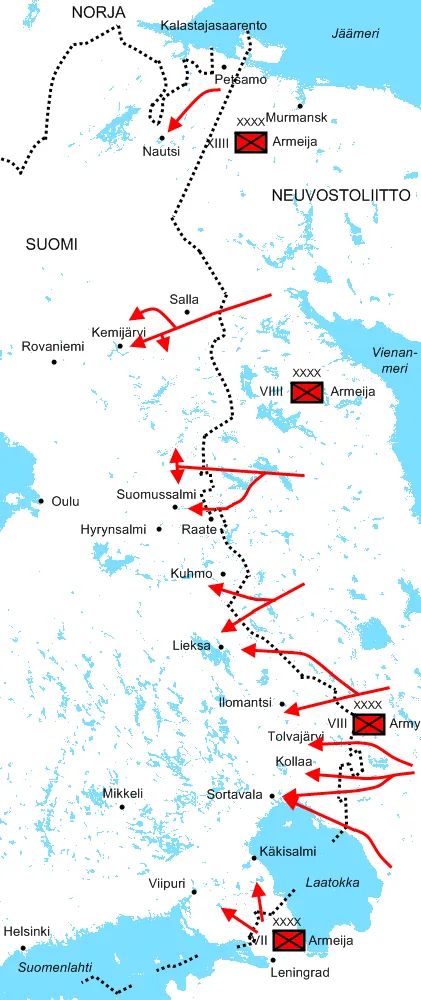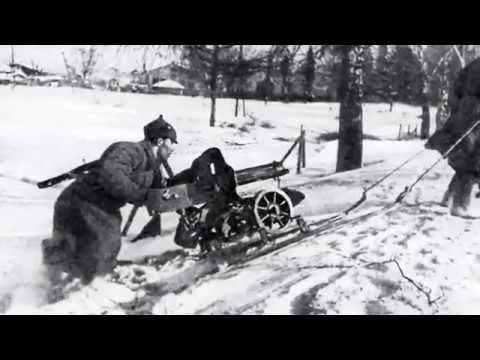This is a true story of events that took place on a hill called Mäntyvaara about 20 km to the east of the town of Kemijärvi, Finland, on December 20 1939.

Kemijärvi is close to the northern edge of the map.
Background
Hitler and Stalin had agreed according to a secret protocol of the Molotov-Ribbentrop Pact in August 1939 that Finland would belong to the Soviet sphere of interest as part of the division of the parts of Europe between the two powers into their spheres of interest. In the autumn of 1939, negotiations failed between Finland and the Soviet Union and the latter invaded Finland on November 30 1939.
The Salla section of the front
The Soviet Union had superiority in troops and materiel in all parts of the front. Nowhere was the superiority of the Red Army as large as in sparsely populated Lapland. In particular, the Finnish military leadership had not believed that the Soviets would be able to deploy heavy weaponry including tanks and artillery via the bad roads of eastern Lapland. Partly this was made possible by the Soviet use of prison labor to build a road from the town of Kandalaksha to the border prior to the war.

Initially, the defenders had only one detached battalion and one detached company. The Red Army deployed two infantry divisions. The Soviets advanced over 100 km from the old border in just three weeks. The evacuations of the civilians from the border regions had been partially neglected according to those present at the time.
Below is a link to YouTube documentary about the critical days and weeks told by civilians and former soldiers who were there (English subtitles):
The Battle of Mäntyvaara
Mäntyvaara is a forested hill a short distance from the road between the town of Kemijärvi and the municipal center of Salla. The battle started by accident. A battalion of Red Army Infantry Regiment 396 had gone around the Finnish defenses on the road leading to Kemijärvi. Detached Battalion 17 was ordered to be in reserve in Mäntyselkä, about 5 km to the west of Mäntyvaara, but a runner had misheard or remembered his orders incorrectly, which is why the battalion had moved to Mäntyvaara instead.
The battle began during the twilight at 2 pm and continued during the dark. It was only afternoon but the day is very short on the arctic circle at winter solstice.
At first, the battle was fought with the usual infantry weapons: rifles, machine guns and hand grenades. Gradually it became a melee where friend and foe were mixed up. At that point the weapons used were bayonets and knives. The battle raged for a few hours in the dark. There was about 15 cm of snow and the temperature was -20 C.
The result of the battle was the destruction of the Red Army battalion and the death of the regiment commander. The fallen Red Army soldiers, a total of 380, lie in mass graves dug around the hill. The defenders, most of whom were from the area, lost 17 men killed in action.
If the Red Army had won that particular battle, the road would've been open to the town of Kemijärvi just 20 km west and from there to the regional capital Rovaniemi onwards and the Swedish border, which was the ultimate objective.
Not the only fortunate event
In the Battle of Pelkosenniemi to the north (see map above), the Soviets had to cross the river Kemijoki by ferry. Using tanks, they managed to capture the village of Pelkosenniemi, also the municipal center of Pelkosenniemi. During the counterattack, chaos broke out among the enemy troops because the driver of the regiment commander's car was shot and he fell on the steering wheel. The Soviets had been ordered to retreat upon hearing that noise.
Scandinavian and other volunteers
Although Sweden was officially neutral during the Winter War, the Swedish people understood how dangerous it would be if Finland fell into Soviet hands. 8000 Swedish volunteers arrived to strengthen the Salla section of the front in January along with 700 Norwegians. Fighter Regiment 19 of the Swedish Air Force, manned by volunteers, also arrived in January. The Finnish air force had no aircraft to available in the north.
The actor Christopher Lee volunteered to fight in the Winter War at the age of 17. He had joined military academy earlier that year. Lee did not see battle.
